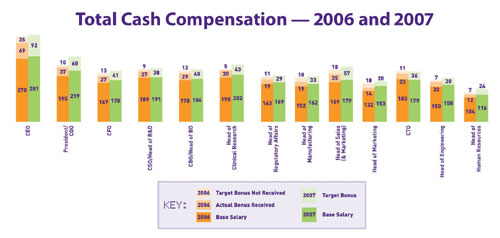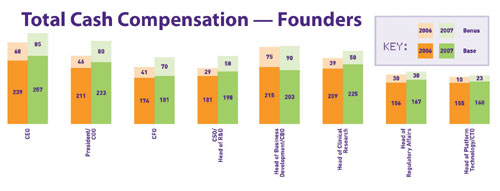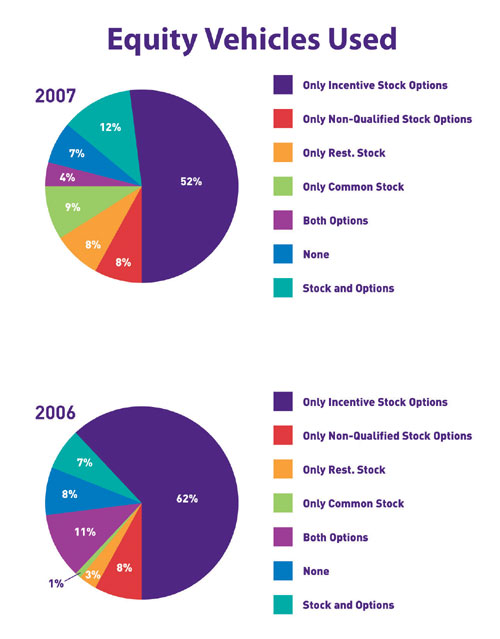March 1, 2008 (Vol. 28, No. 5)
Bryan Pearce
Knowing What Other Firms Are Doing Can Help when Establishing Remuneration for Personnel
The life sciences industry is evolving at a rapid pace. This growth continues to sustain a job market that forces companies to plan their employee attraction and retention policies carefully with an eye on the competition.
Each year, Ernst & Young teams up with J. Robert Scott, WilmerHale, and the Harvard Business School to examine compensation trends in the life science industry. This year, we gathered data from over 1,000 executives at more than 165 private biopharmaceutical, therapeutic, bioinformatic, genomic and molecular technology, and medical device/diagnostic companies.

Total Cash Compensation – 2006 and 2007
“Awareness of changing compensation trends allows businesses to understand the executive talent pool and to better align their compensation strategies and programs with current market conditions,” says Bruce Rychlik, managing director at J. Robert Scott. “The compensation study includes significant data on cash compensation, base salaries, bonuses, and equity holdings. In the past, reliable equity and cash compensation figures have only been available for public biotechnology companies. This compensation study provides much-needed statistics on the changing dynamics for senior executives within private, venture-backed life science companies,” he says.
Researchers discovered that, on average, across all 13 executive positions surveyed, base salaries increased 5.9% from 2006 to 2007. Nonfounder CEOs experienced a 3.9% rise in base salary, from an average of $270,000 in 2006 to $281,000 in 2007. Overall, target bonuses figured on a percentage of base salary, did not change significantly from 2006 to 2007. Bonuses made up an average of 25% of CEO salaries, with other positions being somewhat lower. Together with the CEO, heads of engineering and heads of sales and marketing were most likely to receive bonuses.
Founder and Nonfounder CEOs
The survey results indicate that, in general, founding executives earn less than their nonfounding counterparts, particularly in average base salary. Nonfounding CEOs earn as much as a 10% premium over founding CEOs, or an average base salary of $281,000. Founding CEOs, however, are gaining ground with an 8% increase in base salary from 2006 to 2007, compared to a 3.9% increase for nonfounder CEOs.
Founders most often hold key positions in the company such as CEO, CSO, head of R&D, or CTO, according to survey findings. Interestingly, as the number of financing rounds increases, the percentage of founders in the CEO position decreases, from 55% for companies with one to three financing rounds to 31% at companies with four or more financing rounds.
Founder CEOs appear to transition into roles like CSO or head of clinical research as financing rounds increase, or they exit the company, often to commence a new early-stage endeavor.
The vast majority, 72% of nonfounding CEOs we surveyed, held severance packages. The median severance period for these respondents was 12 months, whereas the rest of the management team had severance periods most often set at six months. With the exception of the CEO and president/COO, the nonfounding executive team had a severance package between one-third and one-half of the time.

Total Cash Compensation – Founders
Equity holdings continue to be an important part of compensation packages. Across all 13 positions we surveyed, combined average equity holdings equaled approximately 18%, a two percentage point increase from our 2006 survey.
The mix of equity vehicles took a significant turn. While stock options continued to dominate, accounting for over one-half of equity grants to management, companies using only stock options decreased to 64% from 81% in 2006. The decrease was offset by a significant increase in restricted or common stock grants, 17% of equity grants, from 4% in 2006.

Equity Vehicles Used
According to the survey, board members were granted an average 0.45% (0.50% for the chairperson) of fully diluted equity to join the board. Outside board members held an average of 1.61% of the company’s equity (2.65% for the chairperson). Most outside board members at private companies did not receive any cash compensation.
The survey results did indicate some variation in compensation packages for CEOs depending on geography. CEOs in California still enjoy the highest base salary at $296,000 compared to $294,000 in the West/Midwest regions, and $263,000 in New England.
With expected bonus layered on top of the base salary, the West/Midwest leads with total cash compensation of $405,000, followed by California at $373,000. Mid-Atlantic CEOs also receive higher equity stakes at 6.6% of fully diluted ownership compared to 4.83% in New England, and 4.52% in California.
California also leads the regions in base salary for CSOs, with an average of $224,000 compared to $155,000 in the Mid-Atlantic and New England at $194,000. On the other hand, New England is the leader in expected bonuses with $41,000 followed by the Mid-Atlantic at $40,000 and California at $38,000. New England companies also pay a premium for clinical research heads, with an average cash compensation of $289,000 compared to California’s $272,000.
Heads of sales and marketing in New England received the highest total cash compensation packages, when compared to equivalents in other regions, averaging $266,000, of which $196,000 is base salary. This indicates a high demand for executives in that region. Sales and marketing executives in the Mid-Atlantic follow with total cash compensation of $248,000, including a base salary of $189,000, while California had total cash compensation of $218,000, including a base salary of $172,000.
Salaries Equal Growth
As companies increase in size, the top executive positions also see an increase in total cash compensation packages. CEOs at the smallest companies, 10 or fewer employees on average, will earn $338,000 if target bonuses are met, compared to CEOs at larger companies with over 40 employees, earning as much as $429,000 in total compensation. This equals a 27% premium. CSOs follow the same trend, with a total cash compensation of $211,000 if bonus targets are met for smaller companies, compared to $264,000 for larger companies, adding up to a 25% premium.
As companies expand and the number of employees grows, the executives’ equity ownership gets smaller. CEO fully-diluted equity ownership decreased from 7.04% for smaller companies to 4.35% for larger companies, or a 38% decrease. CSO equity ownership also followed a similar decrease of 37% from 1.71% ownership in smaller companies to 1.07% ownership in larger companies.
Life science CEOs continue to outpace their medical-device counterparts in annual base salary and target bonus. In 2007, the average base salary for a life science CEO was $286,000, compared to $262,000 for medical-device company CEOs.
Expected bonuses of $108,000 for life science CEOs also outpaced those of medical-device CEOs, which average $76,000.
Heads of sales and marketing at life science companies earn the second highest salary of all executives, with total cash compensation of $276,000. Nearly a quarter of this is expected bonus. At medical-device companies, sales and marketing heads earned average total cash compensation of $219,000, 22% of which is expected bonus.
Locating talent can be a challenge. Our 2007 survey results indicated that the majority of executives other than the CEO are found either by referral of the CEO or other executives. Investors have the most influence over the hiring of CEOs, business development executives, and CFOs. With all other positions, however, investors referred the lowest percentage of executives.
Bryan Pearce is the strategic growth markets leader for the northeast at Ernst & Young. E-mail: [email protected].



